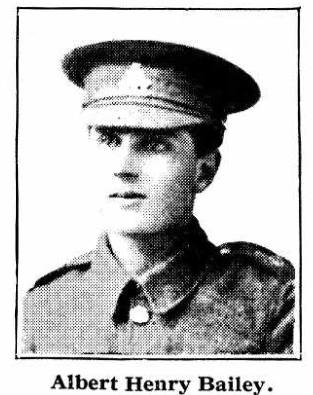Pte
Albert Henry Bailey
Information about birth
|
Date of birth: 06/06/1895 |
|
Place of birth: Portfield, Chichester, Sussex, England, United Kingdom |
General information
|
Profession: Carpenter |
Army information
|
Country: England, United Kingdom |
|
Force: British Expeditionary Force |
|
Rank: Private |
|
Service number: G/17779 |
|
Enlistment date: 21/09/1914 |
|
Enlistment place: Petworth, Chichester, West Sussex, England, United Kingdom |
|
Units: — Royal Sussex Regiment, 12th Bn. (Last known unit) |
Information about death
|
Date of death: 26/09/1917 |
|
Place of death: Kantintje Cabaret, Belgium |
|
Cause of death: Killed in action (K.I.A.) |
|
Age: 22 |
Cemetery
|
Tyne Cot Cemetery Plot: 44 Row: G Grave: 37 |
Points of interest 3
| #1 | Place of birth | ||
| #2 | Enlistment place | ||
| #3 | Place of death (approximate) |
My story
Albert Henry Bailey was born on June 6, 1895, in Portfield, Chichester, Sussex, and remained the only son of Henry Bailey and Charlotte Cheetam. Before joining the British Army, he worked as a carpenter. On September 21, 1914, Albert enlisted and was assigned to the 1/4th Battalion, Royal Sussex Regiment. On July 12, 1916, he was transferred to the 12th Battalion, Royal Sussex Regiment (116th Brigade, 39th Division) and began his service in both France and Belgium.
Albert Henry Bailey was killed in action at the age of 22 on September 26, 1917, during the Battle of Polygon Wood, part of the Battle of Passchendaele.
On September 23, 1917, the 12th Battalion received orders to move to the front line at Tower Hamlets, near the Menin Road. On September 25, German troops attacked positions along the Menin Road. The 12th Battalion remained in the support line throughout the day, providing supplies of ammunition, water, and food. On September 26, the Battle of Polygon Wood broke out. In the 39th Division’s sector, south of the Menin Road and west of Geluveld, several battalions launched an attack. Their objective was to capture the positions at Tower Hamlets. The 12th Battalion stayed in the trenches to provide support. The German positions at Tower Hamlets were taken by the attacking battalions, who then established a new defensive line running from the Menin Road to Joist Redoubt, just behind Tower Trench. The next day, the 12th Battalion was relieved by the 13th Battalion, Rifle Brigade. During their time in support, they endured heavy artillery fire. Forty-eight soldiers were killed, 117 were wounded, and 26 were reported missing.
Albert Henry Bailey’s body was found near Katintje Cabaret after the war and reburied at Tyne Cot Cemetery, Plot XLIV, Row G, Grave 37.
Albert Henry Bailey was killed in action at the age of 22 on September 26, 1917, during the Battle of Polygon Wood, part of the Battle of Passchendaele.
On September 23, 1917, the 12th Battalion received orders to move to the front line at Tower Hamlets, near the Menin Road. On September 25, German troops attacked positions along the Menin Road. The 12th Battalion remained in the support line throughout the day, providing supplies of ammunition, water, and food. On September 26, the Battle of Polygon Wood broke out. In the 39th Division’s sector, south of the Menin Road and west of Geluveld, several battalions launched an attack. Their objective was to capture the positions at Tower Hamlets. The 12th Battalion stayed in the trenches to provide support. The German positions at Tower Hamlets were taken by the attacking battalions, who then established a new defensive line running from the Menin Road to Joist Redoubt, just behind Tower Trench. The next day, the 12th Battalion was relieved by the 13th Battalion, Rifle Brigade. During their time in support, they endured heavy artillery fire. Forty-eight soldiers were killed, 117 were wounded, and 26 were reported missing.
Albert Henry Bailey’s body was found near Katintje Cabaret after the war and reburied at Tyne Cot Cemetery, Plot XLIV, Row G, Grave 37.
Sources 5
|
12 Battalion Royal Sussex Regiment, (The National Archives, KEW (TNA), WO 95/2582/2). https://www.nationalarchives.gov.uk/ Sources used |
|
Census Returns of England and Wales, 1901 (The National Archives, Kew (TNA), RG13). http://Ancestry.com Sources used |
|
McCarthy, Chris. Passchendaele: The Day by Day Account (Londen: Arms & Armour Press, 1995), 91 - 92. Sources used |
|
UK, De Ruvigny's Roll of Honour, 1914-1919, vol.3, p.12. https://www.ancestry.com/ Sources used |
|
UK, Soldiers Died in the Great War, 1914-1919, His Majesty's Stationery Office (HMSO), 1921. http://Ancestry.com Sources used |
More information 3
|
Commonwealth War Graves Commission Database https://www.cwgc.org/find-records/find-war-dead/casualty-details/461790 |
|
Namenlijst (In Flanders Fields Museum) https://namenlijst.org/publicsearch/#/person/_id=0287f43e-62d8-4f7e-8058-8fcec095a50c |
|
Lives of the First World War (Imperial War Museum) https://livesofthefirstworldwar.iwm.org.uk/lifestory/124940 |
